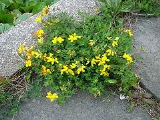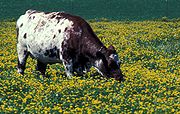
Lotus corniculatus
Encyclopedia
Lotus corniculatus is a common flowering plant
native to grassland temperate Eurasia
and North Africa
. The common name is Bird's-foot Trefoil (or similar, such as "birdsfoot trefoil"), though the common name is often also applied to other members of the genus. It is also known in cultivation in North America
as Birdfoot Deervetch.
It is a perennial
herb
aceous plant, similar in appearance to some clover
s. The flowers develop into small pea-like pods or legumes. The name 'bird's foot' refers to the appearance of the seed pods on their stalk. There are five leaf
lets, but with the central three held conspicuously above the others, hence the use of the name trefoil.
The height of the plant is variable, from 5-20 cm, occasionally more where supported by other plants; the stems can reach up to 50 cm long. It is typically sprawling at the height of the surrounding grassland. It can survive fairly close grazing, trampling and mowing. It is most often found in sandy soil
s. It Flowers from June until September.
The plant has had many common English
names in Britain, which are now mostly out of use. These names were often connected with the yellow and orange colour of the flowers, e.g. 'butter and eggs'. One name that is still used is Eggs and Bacon.
 It is used in agriculture
It is used in agriculture
as a forage
plant, grown for pasture
, hay
, and silage
. Taller growing cultivar
s have been developed for this. It may be used as an alternative to alfalfa
in poor soils. It has become an invasive species
in some regions of North America
and Australia
.
A double flowered variety is grown as an ornamental plant
. The plant is an important nectar source for many insect
s and is also used as a larva
l food plant by many species of Lepidoptera
such as Six-spot Burnet
. It is regularly included as a component of wildflower
mixes in Europe
. Fresh birdsfoot trefoil contains cyanogenic glycosides and is thus poison
ous to humans.
The plant is one of the few flowers in the language of flowers
that has a negative connotation, symbolizing revenge or retribution.
Flowering plant
The flowering plants , also known as Angiospermae or Magnoliophyta, are the most diverse group of land plants. Angiosperms are seed-producing plants like the gymnosperms and can be distinguished from the gymnosperms by a series of synapomorphies...
native to grassland temperate Eurasia
Eurasia
Eurasia is a continent or supercontinent comprising the traditional continents of Europe and Asia ; covering about 52,990,000 km2 or about 10.6% of the Earth's surface located primarily in the eastern and northern hemispheres...
and North Africa
Africa
Africa is the world's second largest and second most populous continent, after Asia. At about 30.2 million km² including adjacent islands, it covers 6% of the Earth's total surface area and 20.4% of the total land area...
. The common name is Bird's-foot Trefoil (or similar, such as "birdsfoot trefoil"), though the common name is often also applied to other members of the genus. It is also known in cultivation in North America
North America
North America is a continent wholly within the Northern Hemisphere and almost wholly within the Western Hemisphere. It is also considered a northern subcontinent of the Americas...
as Birdfoot Deervetch.
It is a perennial
Perennial plant
A perennial plant or simply perennial is a plant that lives for more than two years. The term is often used to differentiate a plant from shorter lived annuals and biennials. The term is sometimes misused by commercial gardeners or horticulturalists to describe only herbaceous perennials...
herb
Herb
Except in botanical usage, an herb is "any plant with leaves, seeds, or flowers used for flavoring, food, medicine, or perfume" or "a part of such a plant as used in cooking"...
aceous plant, similar in appearance to some clover
Clover
Clover , or trefoil, is a genus of about 300 species of plants in the leguminous pea family Fabaceae. The genus has a cosmopolitan distribution; the highest diversity is found in the temperate Northern Hemisphere, but many species also occur in South America and Africa, including at high altitudes...
s. The flowers develop into small pea-like pods or legumes. The name 'bird's foot' refers to the appearance of the seed pods on their stalk. There are five leaf
Leaf
A leaf is an organ of a vascular plant, as defined in botanical terms, and in particular in plant morphology. Foliage is a mass noun that refers to leaves as a feature of plants....
lets, but with the central three held conspicuously above the others, hence the use of the name trefoil.
The height of the plant is variable, from 5-20 cm, occasionally more where supported by other plants; the stems can reach up to 50 cm long. It is typically sprawling at the height of the surrounding grassland. It can survive fairly close grazing, trampling and mowing. It is most often found in sandy soil
Soil
Soil is a natural body consisting of layers of mineral constituents of variable thicknesses, which differ from the parent materials in their morphological, physical, chemical, and mineralogical characteristics...
s. It Flowers from June until September.
The plant has had many common English
English language
English is a West Germanic language that arose in the Anglo-Saxon kingdoms of England and spread into what was to become south-east Scotland under the influence of the Anglian medieval kingdom of Northumbria...
names in Britain, which are now mostly out of use. These names were often connected with the yellow and orange colour of the flowers, e.g. 'butter and eggs'. One name that is still used is Eggs and Bacon.
Uses

Agriculture
Agriculture is the cultivation of animals, plants, fungi and other life forms for food, fiber, and other products used to sustain life. Agriculture was the key implement in the rise of sedentary human civilization, whereby farming of domesticated species created food surpluses that nurtured the...
as a forage
Fodder
Fodder or animal feed is any agricultural foodstuff used specifically to feed domesticated livestock such as cattle, goats, sheep, horses, chickens and pigs. Most animal feed is from plants but some is of animal origin...
plant, grown for pasture
Pasture
Pasture is land used for grazing. Pasture lands in the narrow sense are enclosed tracts of farmland, grazed by domesticated livestock, such as horses, cattle, sheep or swine. The vegetation of tended pasture, forage, consists mainly of grasses, with an interspersion of legumes and other forbs...
, hay
Hay
Hay is grass, legumes or other herbaceous plants that have been cut, dried, and stored for use as animal fodder, particularly for grazing livestock such as cattle, horses, goats, and sheep. Hay is also fed to pets such as rabbits and guinea pigs...
, and silage
Silage
Silage is fermented, high-moisture fodder that can be fed to ruminants or used as a biofuel feedstock for anaerobic digesters. It is fermented and stored in a process called ensiling or silaging, and is usually made from grass crops, including corn , sorghum or other cereals, using the entire...
. Taller growing cultivar
Cultivar
A cultivar'Cultivar has two meanings as explained under Formal definition. When used in reference to a taxon, the word does not apply to an individual plant but to all those plants sharing the unique characteristics that define the cultivar. is a plant or group of plants selected for desirable...
s have been developed for this. It may be used as an alternative to alfalfa
Alfalfa
Alfalfa is a flowering plant in the pea family Fabaceae cultivated as an important forage crop in the US, Canada, Argentina, France, Australia, the Middle East, South Africa, and many other countries. It is known as lucerne in the UK, France, Australia, South Africa and New Zealand, and known as...
in poor soils. It has become an invasive species
Invasive species
"Invasive species", or invasive exotics, is a nomenclature term and categorization phrase used for flora and fauna, and for specific restoration-preservation processes in native habitats, with several definitions....
in some regions of North America
North America
North America is a continent wholly within the Northern Hemisphere and almost wholly within the Western Hemisphere. It is also considered a northern subcontinent of the Americas...
and Australia
Australia
Australia , officially the Commonwealth of Australia, is a country in the Southern Hemisphere comprising the mainland of the Australian continent, the island of Tasmania, and numerous smaller islands in the Indian and Pacific Oceans. It is the world's sixth-largest country by total area...
.
A double flowered variety is grown as an ornamental plant
Ornamental plant
Ornamental plants are plants that are grown for decorative purposes in gardens and landscape design projects, as house plants, for cut flowers and specimen display...
. The plant is an important nectar source for many insect
Insect
Insects are a class of living creatures within the arthropods that have a chitinous exoskeleton, a three-part body , three pairs of jointed legs, compound eyes, and two antennae...
s and is also used as a larva
Larva
A larva is a distinct juvenile form many animals undergo before metamorphosis into adults. Animals with indirect development such as insects, amphibians, or cnidarians typically have a larval phase of their life cycle...
l food plant by many species of Lepidoptera
Lepidoptera
Lepidoptera is a large order of insects that includes moths and butterflies . It is one of the most widespread and widely recognizable insect orders in the world, encompassing moths and the three superfamilies of butterflies, skipper butterflies, and moth-butterflies...
such as Six-spot Burnet
Six-spot Burnet
The Six-spot Burnet, Zygaena filipendulae, is a day-flying moth of the family Zygaenidae. It is a common species throughout Europe....
. It is regularly included as a component of wildflower
Wildflower
A wildflower is a flower that grows wild, meaning it was not intentionally seeded or planted. Yet "wildflower" meadows of a few mixed species are sold in seed packets. The term "wildflower" has been made vague by commercial seedsmen who are interested in selling more flowers or seeds more...
mixes in Europe
Europe
Europe is, by convention, one of the world's seven continents. Comprising the westernmost peninsula of Eurasia, Europe is generally 'divided' from Asia to its east by the watershed divides of the Ural and Caucasus Mountains, the Ural River, the Caspian and Black Seas, and the waterways connecting...
. Fresh birdsfoot trefoil contains cyanogenic glycosides and is thus poison
Poison
In the context of biology, poisons are substances that can cause disturbances to organisms, usually by chemical reaction or other activity on the molecular scale, when a sufficient quantity is absorbed by an organism....
ous to humans.
The plant is one of the few flowers in the language of flowers
Language of flowers
The language of flowers, sometimes called floriography, was a Victorian-era means of communication in which various flowers and floral arrangements were used to send coded messages, allowing individuals to express feelings which otherwise could not be spoken...
that has a negative connotation, symbolizing revenge or retribution.

